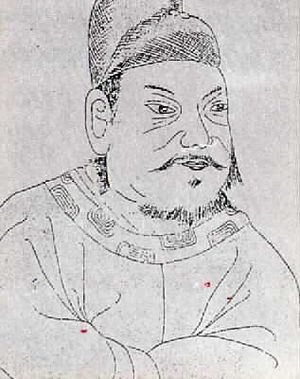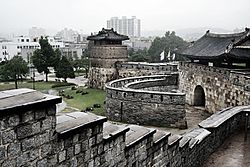Jeongjo of Joseon facts for kids
Quick facts for kids Jeongjo of Joseon朝鮮正祖 조선 정조 |
|||||||||
|---|---|---|---|---|---|---|---|---|---|
 |
|||||||||
| King of Joseon | |||||||||
| Reign | 27 April 1776 – 18 August 1800 | ||||||||
| Coronation | Sungjeongmun Gate, Gyeonghui Palace, Hanseong, Kingdom of Joseon | ||||||||
| Predecessor | Yeongjo of Joseon | ||||||||
| Successor | Sunjo of Joseon | ||||||||
| Grand Heir of Joseon | |||||||||
| Tenure | 10 March 1759 – 27 April 1776 | ||||||||
| Predecessor | Grand Heir Yi Jeong | ||||||||
| Successor | Grand Heir Yi Hwan | ||||||||
| Regent of Joseon | |||||||||
| Tenure | 1775 - 27 April 1776 | ||||||||
| Predecessor | Crown Prince Yi Seon | ||||||||
| Successor | Crown Prince Yi Yeong | ||||||||
| Monarch | Yeongjo | ||||||||
| Born | 28 October 1752 Gyeongchunjeon Hall, Changgyeong Palace, Hanseong, Kingdom of Joseon |
||||||||
| Died | 18 August 1800 (aged 47) Yeongchunheon Hall, Changgyeong Palace, Hanseong, Kingdom of Joseon |
||||||||
| Burial | Geonneung Tombs, Hwaseong, Gyeonggi Province, South Korea | ||||||||
| Spouse | Queen Hyoui | ||||||||
| Issue | Sunjo of Joseon | ||||||||
|
|||||||||
| Clan | Jeonju Yi clan | ||||||||
| Dynasty | House of Yi | ||||||||
| Father |
|
||||||||
| Mother |
|
||||||||
| Religion | Korean Confucianism (Neo-Confucianism) | ||||||||
| Signature |  |
||||||||
| Korean name | |
| Hangul | |
|---|---|
| Hanja | |
| Revised Romanization | Jeongjong, later Jeongjo |
| McCune–Reischauer | Chŏngjong, later Chŏngjo |
| Birth name | |
| Hangul | |
| Hanja | |
| Revised Romanization | I San / I Seong |
| McCune–Reischauer | Yi San / Yi Sŏng |
| Courtesy name | |
| Hangul | |
| Hanja | |
| Revised Romanization | Hyeongun |
| McCune–Reischauer | Hyŏngun |
| Art name | |
| Hangul | |
| Hanja | |
| Revised Romanization | Hongjae |
| McCune–Reischauer | Hongchae |
Jeongjo of Joseon (born October 28, 1752 – died August 18, 1800), whose personal name was Yi San, was the 22nd king of the Joseon dynasty in Korea. He is sometimes called Jeongjo the Great. After becoming king, he worked hard to make many changes and improvements to the country.
Contents
Biography
Early Life and Challenges
Jeongjo was the son of Crown Prince Sado and Lady Hyegyeong. His mother, Lady Hyegyeong, wrote a famous book called Memoirs of Lady Hyegyeong. This book tells a lot about what happened in the royal family during her time.
In 1762, a sad event happened: his father, Crown Prince Sado, was put to death by King Yeongjo, Jeongjo's grandfather. This happened after many disagreements between them.
To protect Jeongjo's right to the throne, King Yeongjo ordered him to be adopted by Crown Prince Hyojang. Crown Prince Hyojang was Sado's older half-brother who had passed away as a child. This adoption was meant to make Jeongjo's claim to the throne stronger.
However, some powerful groups, like the Noron party, tried to stop Jeongjo from becoming king. They argued that he shouldn't rule because of what happened to his father. This caused a lot of trouble for King Yeongjo and Jeongjo.
While he was still a prince, Jeongjo got help from important people. One was Hong Guk-yeong, a politician who strongly supported Jeongjo. Another helper was Kim Jong-su. In 1775, a year before his grandfather died, Jeongjo started to rule as a regent, helping King Yeongjo.
Becoming King and His Goals
Jeongjo became king on March 10, 1776. The first thing he did was declare that he was the son of Crown Prince Sado. He wanted everyone to know that he was proud of his father and wanted to clear his name.
He tried to understand his people's problems. For example, during a severe drought in his second year, he performed a special ritual to pray for rain, showing he cared deeply for his people.
Just like his grandfather, Jeongjo used a method called Tangpyeong. This method aimed to balance different political groups. He hoped this would stop the fighting between parties that had caused his father's death.
Reforms and New Ideas
King Jeongjo spent much of his time trying to restore his father's honor. He moved the royal court to Suwon to be closer to his father's tomb. He also built the impressive Hwaseong Fortress to protect the tomb. Today, Hwaseong Fortress is a UNESCO World Heritage Site.
Jeongjo faced threats from officials who did not support him. But with the help of people like Hong Guk-yeong and Kim Chong-su, he managed to overcome these challenges.
He also made a royal rule that his mother, Lady Hyegyeong, should be given the title of Queen Dowager. This was because her husband, Crown Prince Sado, would have been king if he had lived.
In 1776, some members of the Noron party tried to overthrow him and even planned to assassinate him. Jeongjo bravely fought the rebels in the palace and arrested them himself. He punished those who were involved in the plot.
Jeongjo also created a new group of royal bodyguards called the Changyongyeong in 1785. He chose these officers carefully after special tests. He did this because he didn't fully trust the older royal guard unit.
A Time of Growth and Learning
King Jeongjo led a period of great growth and development in the Joseon Dynasty. He wanted to improve the country's culture and politics.
He created Kyujanggak, a royal library. This library was important for improving the country's knowledge and for finding talented people to work in the government. Jeongjo also allowed people from lower social classes to get government jobs, which was a big change.
Jeongjo was very knowledgeable about philosophy and different ways of thinking. He studied many books and had the support of scholars who believed in practical learning, known as Silhak scholars. These included famous thinkers like Jeong Yak-yong and Pak Ji-won. His reign also saw the growth of popular culture in Joseon.
He made sure to include members from different political groups in his government. This was to create a balance of power and strengthen the king's authority.
In 1791, Jeongjo introduced a new rule called Shinhae Tonggong. This rule helped people sell their goods more easily by getting rid of special selling rights that only a few merchants in Seoul had.
His Final Years
In his last years, Jeongjo arranged for his second son, Sunjo of Joseon, to marry Lady Kim. However, Jeongjo passed away suddenly in 1800 at the age of 47, before seeing his son's marriage. The exact cause of his death is still a mystery and is discussed in many historical books.
He is buried with his wife, Queen Hyoui, at the royal tomb of Geonneung in Hwaseong. In 1899, he was given the special posthumous title of Jeongjo Sanghwangjae.
Family
- Biological father: Yi Seon, King Jangjo of Joseon (born February 13, 1735 – died July 12, 1762)
- Grandfather: King Yeongjo of Joseon (born October 31, 1694 – died April 22, 1776)
- Biological grandmother: Royal Noble Consort Yeong of the Jeonui Yi clan (born August 15, 1696 – died August 23, 1764)
- Biological mother: Queen Heongyeong of the Pungsan Hong clan (born August 6, 1735 – died January 13, 1816)
Consorts and their children:
- Queen Hyoui of the Cheongpung Kim clan (born January 5, 1754 – died April 10, 1821) — No children.
- Royal Noble Consort Su of the Bannam Park clan (born June 1, 1770 – died February 6, 1823)
- Crown Prince Yi Gong (born July 29, 1790 – died December 13, 1834), his second son
- Princess Sukseon (born March 1, 1793 – died June 7, 1836), his second daughter
- Royal Noble Consort Ui of the Changnyeong Seong clan (born August 6, 1753 – died November 4, 1786)
- Yi Sun, Crown Prince Munhyo (born October 13, 1782 – died June 6, 1786), his first son
- First daughter (born March 20, 1784 – died May 12, 1784)
- Royal Noble Consort Won of the Pungsan Hong clan (born May 27, 1766 – died May 7, 1779) — No children.
- Royal Noble Consort Hwa of the Namwon Yun clan (born April 11, 1765 – died January 14, 1824) — No children.
See also
 In Spanish: Jeongjo para niños
In Spanish: Jeongjo para niños


